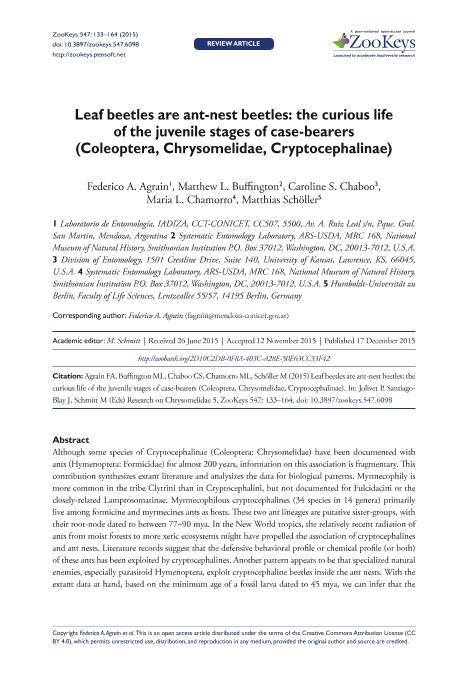Artículo
Leaf beetles are ant-nest beetles: the curious life of the juvenile stages of case-bearers (Coleoptera, Chrysomelidae, Cryptocephalinae)
Agrain, Federico Alejandro ; Buffington, Matthew L.; Chaboo, Caroline S.; Chamorro, Maria L.; Schöller, Matthias
; Buffington, Matthew L.; Chaboo, Caroline S.; Chamorro, Maria L.; Schöller, Matthias
 ; Buffington, Matthew L.; Chaboo, Caroline S.; Chamorro, Maria L.; Schöller, Matthias
; Buffington, Matthew L.; Chaboo, Caroline S.; Chamorro, Maria L.; Schöller, Matthias
Fecha de publicación:
12/2015
Editorial:
Pensoft Publishers
Revista:
ZooKeys
ISSN:
1313-2989
e-ISSN:
1313-2970
Idioma:
Inglés
Tipo de recurso:
Artículo publicado
Clasificación temática:
Resumen
Although some species of Cryptocephalinae (Coleoptera: Chrysomelidae) have been documented with ants (Hymenoptera: Formicidae) for almost 200 years, information on this association is fragmentary. This contribution synthesizes extant literature and analysizes the data for biological patterns. Myrmecophily is more common in the tribe Clytrini than in Cryptocephalini, but not documented for Fulcidacini or the closely-related Lamprosomatinae. Myrmecophilous cryptocephalines (34 species in 14 genera) primarily live among formicine and myrmecines ants as hosts. These two ant lineages are putative sister-groups, with their root-node dated to between 77–90 mya. In the New World tropics, the relatively recent radiation of ants from moist forests to more xeric ecosystems might have propelled the association of cryptocephalines and ant nests. Literature records suggest that the defensive behavioral profile or chemical profile (or both) of these ants has been exploited by cryptocephalines. Another pattern appears to be that specialized natural enemies, especially parasitoid Hymenoptera, exploit cryptocephaline beetles inside the ant nests. With the extant data at hand, based on the minimum age of a fossil larva dated to 45 mya, we can infer that the origin of cryptocephaline myrmecophily could have arisen within the Upper Cretaceous or later. It remains unknown how many times myrmecophily has appeared, or how old is the behavior. This uncertainty is compounded by incongruent hypotheses about the origins of Chrysomelidae and angiosperm-associated lineages of cryptocephalines. Living with ants offers multiple advantages that might have aided the colonization of xeric environments by some cryptocephaline species.
Palabras clave:
Myrmecophily
,
Camptosomata
,
Larvae
,
Biology
,
Clytrini
,
Cryptocephalini
Archivos asociados
Licencia
Identificadores
Colecciones
Articulos(IADIZA)
Articulos de INST. ARG DE INVEST. DE LAS ZONAS ARIDAS
Articulos de INST. ARG DE INVEST. DE LAS ZONAS ARIDAS
Citación
Agrain, Federico Alejandro; Buffington, Matthew L.; Chaboo, Caroline S.; Chamorro, Maria L.; Schöller, Matthias; Leaf beetles are ant-nest beetles: the curious life of the juvenile stages of case-bearers (Coleoptera, Chrysomelidae, Cryptocephalinae); Pensoft Publishers; ZooKeys; 547; 12-2015; 133-164
Compartir
Altmétricas



